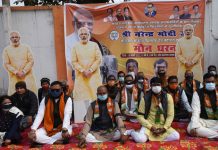 For the past five years, little known to the world outside Kerala, Chamaya Vilakku (make-up lamp), a temple festival organised at the end of March in Kollam district, has been attracting a growing number of transpeople. Every year at Kottamkulangara Devi temple in Chavara, men cross-dress as women as part of a ritual donning gaudy sarees, shiny jewellery and flashy makeup. With strands of jasmine in their hair and lighted lamps in their hands, they line up in the temple premises during the wee hours hoping the presiding deity, Sri Bhagavathy, an incarnation of Durga, would shower them with her blessings. The cross-dressing festival is rooted in the belief that by dressing as a woman, a man can be absolved of his sins.
For the past five years, little known to the world outside Kerala, Chamaya Vilakku (make-up lamp), a temple festival organised at the end of March in Kollam district, has been attracting a growing number of transpeople. Every year at Kottamkulangara Devi temple in Chavara, men cross-dress as women as part of a ritual donning gaudy sarees, shiny jewellery and flashy makeup. With strands of jasmine in their hair and lighted lamps in their hands, they line up in the temple premises during the wee hours hoping the presiding deity, Sri Bhagavathy, an incarnation of Durga, would shower them with her blessings. The cross-dressing festival is rooted in the belief that by dressing as a woman, a man can be absolved of his sins.
Unlike in other parts of the country, where transpeople can be seen in public spaces, say, as beggars on trains and at traffic junctions or as sex workers, they are almost invisible in Kerala. This enforced absence from the public domain makes the temple festival a precious avenue for them to express themselves without inviting gawks, ogles or lewd comments. That is why transpeople from across Kerala as well as from the neighbouring states have been joining the festival in droves since 2000.
“This is the only festival in the state where third gender devotees are welcomed,” says Sheetal, secretary of the Sexual Minorities Forum of Kerala. Sheetal has been a frequent visitor to the festival since 2008. “We believe in the goddess and in divine pursuits. But many of us take part in the festival to enjoy the unrestrained freedom to express ourselves,” she says. “Some also come here hoping to find partners.”
The festival this year, held on 24-25 March, saw a footfall of over 10,000. Of these, more than 6,000 were transpeople, says Sheetal, with some coming from Bengaluru, Mumbai, Chennai and Hyderabad.
Stories about the festival’s origins are plenty. According to the temple website, centuries ago a group of cowherds found a coconut while herding their cattle. One of them picked up the fruit and hit it on a stone to de-husk it, when the stone began to bleed. Frightened, the boys went to the village elders, who in turn approached a local astrologer. Explaining that the stone was a ‘Vana Durga’ (forest goddess), the astrologer told them they had to do penance for the sin of “wounding” the goddess. They were asked to build a temple at the spot where the coconut was found.
The astrologer also asked the cowherd boys to dress as girls and offer prayers in the temple to appease the goddess. Legend has it that the Chamaya Vilakku festival has been held every year since, without a break.
Temple authorities tell TEHELKA that the number of transpeople attending the festival has substantially increased over the past seven years. “We arrange everything to make the devotees feel safe and secure,” says an official.
“There are stray incidents of people making lewd comments or following us to the hotels where we stay. But that is nothing compared to what we face in broad daylight elsewhere in Kerala,” says Sheetal.
Ajay Kollam, who also participated in the festival, says nowhere else do townsfolk show such interest in transpeople. “That’s why we try to bring more transpeople here every year,” he says. “Many locals approach us to know more about our problems. Kerala may have a high rate of literacy but it has not made the residents broadminded enough to give us access to public spaces. This is the only festival that offers us the freedom to dress and move around freely.”
adarsh@tehelka.com













